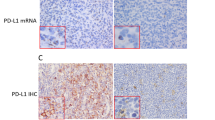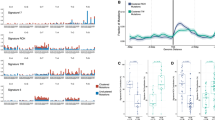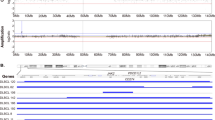Abstract
PRDM1/BLIMP-1, a master regulator of plasma-cell differentiation, is frequently inactivated in activated B-cell-like (ABC) diffuse large B-cell lymphoma (DLBCL) patients. Little is known about its genetic aberrations and relevant clinical implications. A large series of patients with de novo DLBCL was effectively evaluated for PRDM1/BLIMP-1 deletion, mutation, and protein expression. BLIMP-1 expression was frequently associated with the ABC phenotype and plasmablastic morphologic subtype of DLBCL, yet 63% of the ABC-DLBCL patients were negative for BLIMP-1 protein expression. In these patients, loss of BLIMP-1 was associated with Myc overexpression and decreased expression of p53 pathway molecules. In addition, homozygous PRDM1 deletions and PRDM1 mutations within exons 1 and 2, which encode for domains crucial for transcriptional repression, were found to show a poor prognostic impact in patients with ABC-DLBCL but not in those with germinal center B-cell-like DLBCL (GCB-DLBCL). Gene expression profiling revealed that loss of PRDM1/BLIMP-1 expression correlated with a decreased plasma-cell differentiation signature and upregulation of genes involved in B-cell receptor signaling and tumor-cell proliferation. In conclusion, these results provide novel clinical and biological insight into the tumor-suppressive role of PRDM1/BLIMP-1 in ABC-DLBCL patients and suggest that loss of PRDM1/BLIMP-1 function contributes to the overall poor prognosis of ABC-DLBCL patients.
This is a preview of subscription content, access via your institution
Access options
Subscribe to this journal
Receive 12 print issues and online access
$259.00 per year
only $21.58 per issue
Buy this article
- Purchase on Springer Link
- Instant access to full article PDF
Prices may be subject to local taxes which are calculated during checkout




Similar content being viewed by others
References
Lenz G, Staudt LM . Aggressive lymphomas. N Engl J Med 2010; 362: 1417–1429.
DeVita Jr VT, Canellos GP, Chabner B, Schein P, Hubbard SP, Young RC . Advanced diffuse histiocytic lymphoma, a potentially curable disease. Lancet 1975; 1: 248–250.
Coiffier B, Lepage E, Briere J, Herbrecht R, Tilly H, Bouabdallah R et al. CHOP chemotherapy plus rituximab compared with CHOP alone in elderly patients with diffuse large-B-cell lymphoma. N Engl J Med 2002; 346: 235–242.
Coiffier B, Thieblemont C, Van Den Neste E, Lepeu G, Plantier I, Castaigne S et al. Long-term outcome of patients in the LNH-98.5 trial, the first randomized study comparing rituximab-CHOP to standard CHOP chemotherapy in DLBCL patients: a study by the Groupe d'Etudes des Lymphomes de l'Adulte. Blood 2010; 116: 2040–2045.
Friedberg JW . Relapsed/refractory diffuse large B-cell lymphoma. Hematol Am Soc Hematol Educ Program 2011; 2011: 498–505.
Bea S, Zettl A, Wright G, Salaverria I, Jehn P, Moreno V et al. Diffuse large B-cell lymphoma subgroups have distinct genetic profiles that influence tumor biology and improve gene-expression-based survival prediction. Blood 2005; 106: 3183–3190.
Alizadeh AA, Eisen MB, Davis RE, Ma C, Lossos IS, Rosenwald A et al. Distinct types of diffuse large B-cell lymphoma identified by gene expression profiling. Nature 2000; 403: 503–511.
Calado DP, Zhang B, Srinivasan L, Sasaki Y, Seagal J, Unitt C et al. Constitutive canonical NF-kappaB activation cooperates with disruption of BLIMP1 in the pathogenesis of activated B cell-like diffuse large cell lymphoma. Cancer Cell 2010; 18: 580–589.
Crotty S, Johnston RJ, Schoenberger SP . Effectors and memories: Bcl-6 and Blimp-1 in T and B lymphocyte differentiation. Nat Immunol 2010; 11: 114–120.
Shapiro-Shelef M, Lin KI, McHeyzer-Williams LJ, Liao J, McHeyzer-Williams MG, Calame K . Blimp-1 is required for the formation of immunoglobulin secreting plasma cells and pre-plasma memory B cells. Immunity 2003; 19: 607–620.
Mandelbaum J, Bhagat G, Tang H, Mo T, Brahmachary M, Shen Q et al. BLIMP1 is a tumor suppressor gene frequently disrupted in activated B cell-like diffuse large B cell lymphoma. Cancer Cell 2010; 18: 568–579.
Tam W, Gomez M, Chadburn A, Lee JW, Chan WC, Knowles DM . Mutational analysis of PRDM1 indicates a tumor-suppressor role in diffuse large B-cell lymphomas. Blood 2006; 107: 4090–4100.
Pasqualucci L, Compagno M, Houldsworth J, Monti S, Grunn A, Nandula SV et al. Inactivation of the PRDM1/BLIMP1 gene in diffuse large B cell lymphoma. J Exp Med 2006; 203: 311–317.
Tate G, Hirayama-Ohashi Y, Kishimoto K, Mitsuya T . Novel BLIMP1/PRDM1 gene mutations in B-cell lymphoma. Cancer Genet Cytogenet 2007; 172: 151–153.
Visco C, Li Y, Xu-Monette ZY, Miranda RN, Green TM, Li Y et al. Comprehensive gene expression profiling and immunohistochemical studies support application of immunophenotypic algorithm for molecular subtype classification in diffuse large B-cell lymphoma: a report from the International DLBCL Rituximab-CHOP Consortium Program Study. Leukemia 2012; 26: 2103–2113.
Tzankov A, Xu-Monette ZY, Gerhard M, Visco C, Dirnhofer S, Gisin N et al. Rearrangements of MYC gene facilitate risk stratification in diffuse large B-cell lymphoma patients treated with rituximab-CHOP. Mod Pathol 2014; 27: 958–971.
Ok CY, Chen J, Xu-Monette ZY, Tzankov A, Manyam GC, Li L et al. Clinical implications of phosphorylated STAT3 expression in de novo diffuse large B-cell lymphoma. Clin Cancer Res 2014; 20: 5113–5123.
Hu S, Xu-Monette ZY, Tzankov A, Green T, Wu L, Balasubramanyam A et al. MYC/BCL2 protein coexpression contributes to the inferior survival of activated B-cell subtype of diffuse large B-cell lymphoma and demonstrates high-risk gene expression signatures: a report from the International DLBCL Rituximab-CHOP Consortium Program. Blood 2013; 121: 4021–4031.
Xu-Monette ZY, Moller MB, Tzankov A, Montes-Moreno S, Hu W, Manyam GC et al. MDM2 phenotypic and genotypic profiling, respective to TP53 genetic status, in diffuse large B-cell lymphoma patients treated with rituximab-CHOP immunochemotherapy: a report from the International DLBCL Rituximab-CHOP Consortium Program. Blood 2013; 122: 2630–2640.
Visco C, Tzankov A, Xu-Monette ZY, Miranda RN, Tai YC, Li Y et al. Patients with diffuse large B-cell lymphoma of germinal center origin with BCL2 translocations have poor outcome, irrespective of MYC status: a report from an International DLBCL Rituximab-CHOP Consortium Program Study. Haematologica 2013; 98: 255–263.
Xu-Monette ZY, Wu L, Visco C, Tai YC, Tzankov A, Liu WM et al. Mutational profile and prognostic significance of TP53 in diffuse large B-cell lymphoma patients treated with R-CHOP: report from an International DLBCL Rituximab-CHOP Consortium Program Study. Blood 2012; 120: 3986–3996.
Dybkaer K, Bogsted M, Falgreen S, Bodker JS, Kjeldsen MK, Schmitz A et al. Diffuse large B-cell lymphoma classification system that associates normal B-cell subset phenotypes with prognosis. J Clin Oncol 2015; 33: 1379–1388.
Lin R, Chen L, Chen G, Hu C, Jiang S, Sevilla J et al. Targeting miR-23a in CD8+ cytotoxic T lymphocytes prevents tumor-dependent immunosuppression. J Clin Invest 2014; 124: 5352–5367.
White CA, Pone EJ, Lam T, Tat C, Hayama KL, Li G et al. Histone deacetylase inhibitors upregulate B cell microRNAs that silence AID and Blimp-1 expression for epigenetic modulation of antibody and autoantibody responses. J Immunol 2014; 193: 5933–5950.
Liang L, Nong L, Zhang S, Zhao J, Ti H, Dong Y et al. The downregulation of PRDM1/Blimp-1 is associated with aberrant expression of miR-223 in extranodal NK/T-cell lymphoma, nasal type. J Exp Clin Cancer Res 2014; 33: 7.
Lin J, Lwin T, Zhao JJ, Tam W, Choi YS, Moscinski LC et al. Follicular dendritic cell-induced microRNA-mediated upregulation of PRDM1 and downregulation of BCL-6 in non-Hodgkin's B-cell lymphomas. Leukemia 2011; 25: 145–152.
Nie K, Zhang T, Allawi H, Gomez M, Liu Y, Chadburn A et al. Epigenetic down-regulation of the tumor suppressor gene PRDM1/Blimp-1 in diffuse large B cell lymphomas: a potential role of the microRNA let-7. Am J Pathol 2010; 177: 1470–1479.
Klein U, Dalla-Favera R . Germinal centres: role in B-cell physiology and malignancy. Nat Rev Immunol 2008; 8: 22–33.
Calfon M, Zeng H, Urano F, Till JH, Hubbard SR, Harding HP et al. IRE1 couples endoplasmic reticulum load to secretory capacity by processing the XBP-1 mRNA. Nature 2002; 415: 92–96.
Namba T, Chu K, Kodama R, Byun S, Yoon KW, Hiraki M et al. Loss of p53 enhances the function of the endoplasmic reticulum through activation of the IRE1alpha/XBP1 pathway. Oncotarget 2015; 6: 19990–20001.
Saito M, Gao J, Basso K, Kitagawa Y, Smith PM, Bhagat G et al. A signaling pathway mediating downregulation of BCL6 in germinal center B cells is blocked by BCL6 gene alterations in B cell lymphoma. Cancer Cell 2007; 12: 280–292.
Ding BB, Yu JJ, Yu RY, Mendez LM, Shaknovich R, Zhang Y et al. Constitutively activated STAT3 promotes cell proliferation and survival in the activated B-cell subtype of diffuse large B-cell lymphomas. Blood 2008; 111: 1515–1523.
Gyory I, Fejer G, Ghosh N, Seto E, Wright KL . Identification of a functionally impaired positive regulatory domain I binding factor 1 transcription repressor in myeloma cell lines. J Immunol 2003; 170: 3125–3133.
Yu J, Angelin-Duclos C, Greenwood J, Liao J, Calame K . Transcriptional repression by blimp-1 (PRDI-BF1) involves recruitment of histone deacetylase. Mol Cell Biol 2000; 20: 2592–2603.
Liu H, Ippolito GC, Wall JK, Niu T, Probst L, Lee BS et al. Functional studies of BCL11A: characterization of the conserved BCL11A-XL splice variant and its interaction with BCL6 in nuclear paraspeckles of germinal center B cells. Mol Cancer 2006; 5: 18.
Gustafson WC, Weiss WA . Myc proteins as therapeutic targets. Oncogene 2010; 29: 1249–1259.
Johnson K, Shapiro-Shelef M, Tunyaplin C, Calame K . Regulatory events in early and late B-cell differentiation. Mol Immunol 2005; 42: 749–761.
Heise N, De Silva NS, Silva K, Carette A, Simonetti G, Pasparakis M et al. Germinal center B cell maintenance and differentiation are controlled by distinct NF-kappaB transcription factor subunits. J Exp Med 2014; 211: 2103–2118.
Liu YY, Leboeuf C, Shi JY, Li JM, Wang L, Shen Y et al. Rituximab plus CHOP (R-CHOP) overcomes PRDM1-associated resistance to chemotherapy in patients with diffuse large B-cell lymphoma. Blood 2007; 110: 339–344.
Kusam S, Vasanwala FH, Dent AL . Transcriptional repressor BCL-6 immortalizes germinal center-like B cells in the absence of p53 function. Oncogene 2004; 23: 839–844.
Martins G, Calame K . Regulation and functions of Blimp-1 in T and B lymphocytes. Annu Rev Immunol 2008; 26: 133–169.
Wright G, Tan B, Rosenwald A, Hurt EH, Wiestner A, Staudt LM . A gene expression-based method to diagnose clinically distinct subgroups of diffuse large B cell lymphoma. Proc Natl Acad Sci USA 2003; 100: 9991–9996.
Montes-Moreno S, Gonzalez-Medina AR, Rodriguez-Pinilla SM, Maestre L, Sanchez-Verde L, Roncador G et al. Aggressive large B-cell lymphoma with plasma cell differentiation: immunohistochemical characterization of plasmablastic lymphoma and diffuse large B-cell lymphoma with partial plasmablastic phenotype. Haematologica 2010; 95: 1342–1349.
Garcia JF, Roncador G, Garcia JF, Sanz AI, Maestre L, Lucas E et al. PRDM1/BLIMP-1 expression in multiple B and T-cell lymphoma. Haematologica 2006; 91: 467–474.
Shaffer AL, Lin KI, Kuo TC, Yu X, Hurt EM, Rosenwald A et al. Blimp-1 orchestrates plasma cell differentiation by extinguishing the mature B cell gene expression program. Immunity 2002; 17: 51–62.
Davis RE, Ngo VN, Lenz G, Tolar P, Young RM, Romesser PB et al. Chronic active B-cell-receptor signalling in diffuse large B-cell lymphoma. Nature 2010; 463: 88–92.
Acknowledgements
This study was supported by grants from the National Institutes of Health/National Cancer Institute (R01CA138688 and 1RC1CA146299 to YL and KHY). YX is a recipient of a hematology and oncology scholarship award. AT was supported by the Krebsliga Beider Basel and Stiftung zur Krebsbekaempfung Zurich. KHY was supported by The University of Texas MD Anderson Cancer Center Lymphoma Moon Shot Program, the Institutional Research and Development Fund, an MD Anderson Institutional Research Grant, an MD Anderson Lymphoma Specialized Program of Research Excellence Research Development Program Award, an MD Anderson Myeloma Specialized Program of Research Excellence Research Development Program Award and a Gundersen Medical Foundation award. In addition, the study was partially supported by grants from the National Institutes of Health/National Cancer Institute (P50CA136411 and P50CA142509) and by the National Institutes of Health/National Cancer Institute under award number P30CA016672. KHY receives research support from Roche Molecular Systems, Gilead Sciences, Seattle Genetics, Daiichi Sankyo, Adaptive Biotechnologies, Incyte and HTG Molecular Diagnostics.
Author information
Authors and Affiliations
Corresponding authors
Ethics declarations
Competing interests
The authors declare no conflict of interest.
Additional information
Supplementary Information accompanies this paper on the Leukemia website
Supplementary information
Rights and permissions
About this article
Cite this article
Xia, Y., Xu-Monette, Z., Tzankov, A. et al. Loss of PRDM1/BLIMP-1 function contributes to poor prognosis of activated B-cell-like diffuse large B-cell lymphoma. Leukemia 31, 625–636 (2017). https://doi.org/10.1038/leu.2016.243
Received:
Revised:
Accepted:
Published:
Issue Date:
DOI: https://doi.org/10.1038/leu.2016.243
This article is cited by
-
Clinicopathologic and mutational profiles of primary breast diffuse large B cell lymphoma in a male patient: case report and literature review
World Journal of Surgical Oncology (2023)
-
Genetic Profiling of Diffuse Large B-Cell Lymphoma: A Comparison Between Double-Expressor Lymphoma and Non-Double-Expressor Lymphoma
Molecular Diagnosis & Therapy (2023)
-
Blimp-1 is a prognostic indicator for progression of cervical intraepithelial neoplasia grade 2
Journal of Cancer Research and Clinical Oncology (2022)
-
Mucosal ribosomal stress-induced PRDM1 promotes chemoresistance via stemness regulation
Communications Biology (2021)
-
Genomic insights into the pathogenesis of Epstein–Barr virus-associated diffuse large B-cell lymphoma by whole-genome and targeted amplicon sequencing
Blood Cancer Journal (2021)



